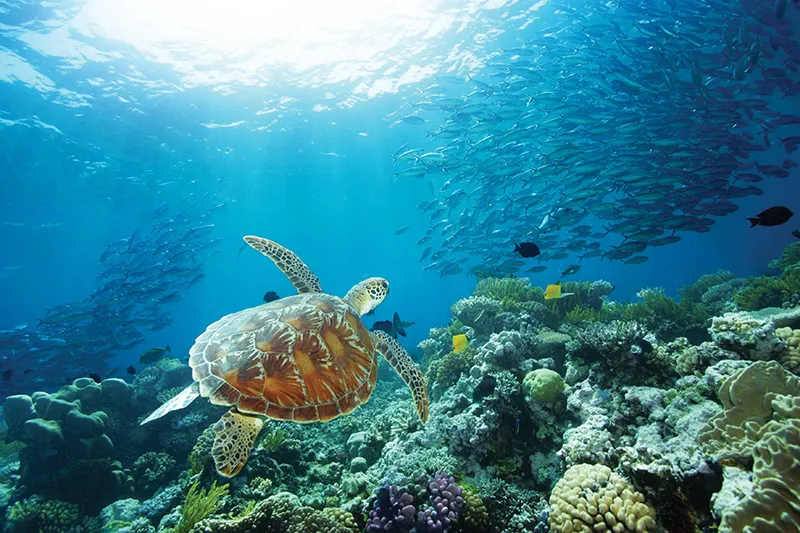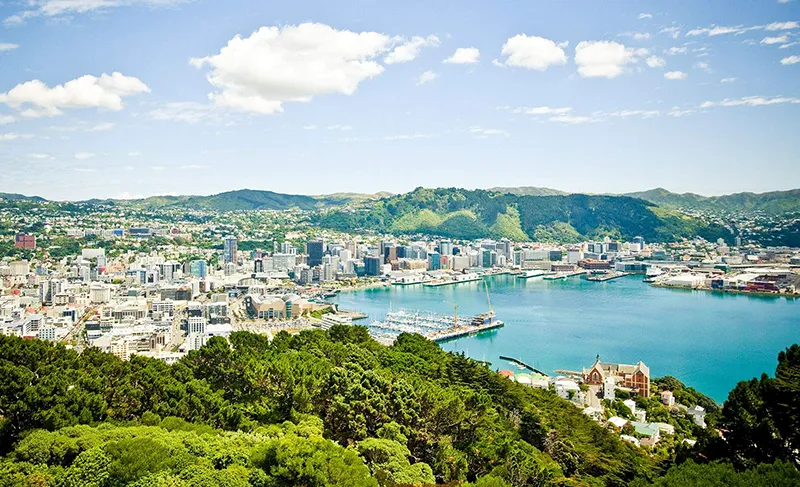The Great Barrier Reef is located in the Coral Sea and is important to Australia’s ecological balance and economy, attracting millions of tourists each year. It consists of more than 2,900 individual reefs and 900 islands spanning more than 2,300 kilometers (1,400 miles) and covering approximately 344,400 square kilometers (133,000 square miles).
A unique world of corals
At low tide only a fraction of the coral is visible above the water’s surface. To see all this beauty you have to dive into the Coral Sea. But where the surf reaches the greatest force and the water temperature varies more sharply than in the deeper layers, the corals are broken more intensively. At the same time, much of the broken coral base is absorbed and gradually joined to other reefs, forming more and more rocks. This eternal cycle of destruction and creation enables corals to survive even after catastrophic destruction.
At its core, coral is the skeleton of a colony of coral polyps, a class of marine invertebrates with a calcareous skeleton of arrowheads. Early in its geologic history, Australia was part of Antarctica and as such was too cold for corals. About 65 million years ago, at the end of the Cretaceous Period, a large part of the continent broke away from Antarctica and began to drift northward toward the tropics.
The shallow waters at the northeastern tip of the new continent, its warmer temperatures and the scattering of small rocks in the Pacific provided ideal conditions for the formation of giant reef-forming coral colonies. The Great Barrier Reef lies on the edge of a gigantic shelf platform, on top of a sinking watershed of rivers through Australia. As the water level in the ocean has risen, the coral has grown – layer upon layer of coral stretching closer to its surface.
Navigating this coral labyrinth is extremely difficult, with the potential for shipwrecks, and so a special marine service monitors the Great Barrier Reef’s tangled fairways every day.
The Great Barrier Reef is so large that it can be viewed from space. It is also the largest natural feature on Earth created by living organisms – billions of coral polyps. The Great Barrier Reef Marine National Park covers over 5 million hectares and was founded in 1979 and is a UNESCO Natural World Heritage Site.
History
It is believed that the first coral reefs in the area began to appear about 18 million years ago. The oldest reefs are 600,000 years old, but most are no older than 400,000 years, with the most intense growth occurring in the last 8,000 years. The youngest reefs are on top of older coral formations, 15-20 m deep, and are no more than 6,000 years old. Reef-forming corals can only grow in warm, shallow, transparent sea water, and they are sensitive to any fluctuations in ocean level – this reaction is evident primarily in their growth rates. For all these reasons, the Great Barrier Reef ecosystem is very vulnerable: water temperature cannot be comfortable for them if it is below +17.5°С, and ideally they need +22º to +27°С. Because of this, the Great Barrier Reef does not go below the Tropic of Capricorn in the south. In addition, corals only grow in water with a certain salinity, and the reef breaks off near the coast of New Guinea, where the full-flowing Fly River (New Guinea) releases an enormous amount of fresh water into the ocean.
Humans began to settle the coral islands of the Great Barrier Reef about 40,000 years ago, after the ancestors of what were later called the Aboriginal people arrived in Australia and settled the Channel (Torres Strait) Islands. These islands attracted people primarily because they were excellent natural harbors for boats. For this reason, sanctuaries for religious cults related to the sea, the weather and successful fishing also appeared here over time.
The first European to sail along the Great Barrier Reef was the famous English explorer James Cook (1728-1779) on his first voyage around the world in 1768-71. In 1770 his ship Endeavour needed urgent repairs. Looking for a place to anchor, Cook led the ship where the Great Barrier Reef fenced it off from the ocean, in a narrow strip of water between the Australian shore and the reef. To get around the reef, Cook had to go north for almost 400 km, and as a result he discovered the Torres Strait between New Guinea and Australia. But it was not until the mid-nineteenth century that people fully traversed the lagoon between the reef and the mainland.
Flora and fauna
Hard corals “work” for the formation of the Great Barrier Reef: the structure of the reef is determined by the structure of their limestone skeletons. The most common types of hard corals are mushroom corals, brain corals, and so-called “deer antlers.
The reef zone is home to many endemic organisms, and they are unusually sensitive to changes in the environment. Corals alone there are more than 400 species here. Most corals are brightly colored, due to the presence of organic pigments in their tissues. Unsurpassed in beauty are considered corals “black”, or Akkabara, and jewelry made of them, but now it is forbidden even to touch them. The diversity of fish living near the Great Barrier Reef (about 1,500 species), especially small multi-colored, “ornate” fish, is striking. This is a gooseneck fish, butterfly fish, parrot fish, and many other species, among which feel at ease moray eels. It is also home to the largest fish in the world’s oceans – the whale shark (up to 20 meters long), as well as 30 species of whales. Reef waters are the breeding grounds of humpback whales, which come here from June to August, and seven species of sea turtles, the latter are now in danger of extinction. The most formidable predator is the saltwater crocodile, the world’s largest reptile, which can grow to six meters in length.
More than 240 bird species nest on the reef islands, among them petrels, phaetons, frigates, pink tern, white-bellied sea eagle. But only about 40 plant species are able to put down roots here.
The Great Barrier Reef stretches along the northeastern coast of Australia. Today, the state of the natural environment and diverse fauna and flora of this coral reef system is mainly of deep concern.
Man’s strict measures of protection are no longer the main enemy of corals, as was thought until recently, but the starfish called the crown of thorns, the only known poisonous species of this invertebrate echinoderm, has taken its place. Up to 50 cm in diameter and up to 19 rays, it ominously named for its many sharp, three-centimeter-long poisonous needles. One such animal devours up to 13 m2 of coral per year. Periodically, there are outbreaks of Thornbill, and then the coral killer rampages across vast areas. The only really effective way to fight this plague is by catching and destroying it with formalin injections.
But the most formidable enemies of corals have always been, are and will always be devastating tropical hurricanes, and in the last two decades, the so-called bleaching caused by global warming has also been added. Each degree of warming is painful for corals, as algae attached to polyps die, resulting in a whitish, essentially dead zone on the reefs.
Tourism
The Great Barrier Reef region is one of the most attractive tourist destinations in Australia and around the world, particularly the Whitsundays. Tourism is a major contributor to the country’s economy, contributing more than six billion dollars a year to its coffers. The Marine National Park is set up to protect the reef and watch out for overzealous fishermen and spearfishers.
The area of the Great Barrier Reef is divided into six zones of accessibility: from the one allowed for all tourists to the closed, even for scientific expeditions. Here, any geological exploration, not to mention oil and gas (despite the fact that there are deposits of both, and in very large quantities), as well as commercial scuba hunting, even without scuba diving, is prohibited. Not only that, underwater divers are not allowed to touch the reefs at all. Will all these conservation measures save the unique world of the Great Barrier Reef from destruction? – One would hope so.
General Information
- 2900 coral reefs and 900 islands ranging in size from one hectare to 100 km2.
- Origin: Volcanic and coral.
- Location: Pacific Ocean, Coral Sea, along the northeast coast of Australia, south to north. Starts off Papua New Guinea south of the equator (Tropic of Capricorn), stretches along the coast of Queensland, Australia, and ends in Torres Strait. The nearest significant town to this location is Bandaberg.
- The islands adapted for recreation are Heron, Dunk, Lizard, Magnetic, Hamilton, Hyman, Bedarra.
- Major coastal settlements: Cairns, Mackay, Townsville, Gladstone.
- Length: 2,500 (some estimates range from 2,300 to 2,600) km.
- Total area: 348,698 km2. Consists of 2,900 individual reefs and 900 coral islands.
- Width: about 2 km in the north, 152 km in the south. At Cape Melville reef begins 32 km from the mainland, in the southern part of the reef distance between him and the mainland in some places is 300 km.
- Depth: about 35 m in the north, about 55 m in the central part, 145 m in the south.
- Distance from the shore: 300 km in the south, 32 km in the north.
Economy
- Fishing.
- Tourism.
Climate and weather
- Hot, subequatorial.
- Coral reefs live in water with a temperature: +26 ºC – +28 ºC.
- Average annual temperature: +27,4ºС.
- Average annual rainfall: 1500 mm.
- Water temperature: +26 ºC – +28 ºC.
- Relative humidity: 85%.
Attractions
-
Islands
- Whitsundays
- Hamilton
- Lizard
- Brampton
- Heima
- Bedarra
- Great Keppel
- Heron
- Lady Elliot
- Magnetic
- Orpheus
- Daydream
- Dunk
-
Coral Reef Agincote
-
Cities
- Cairns
- Port Douglas
- North Beach (mainland Australia, Queensland)
-
National Parks
- Marine National Park, Daintree, Wurunuran, Kuranda Parks, also home to the Tjapukai Aboriginal Theatre, Ebenange Swamp, Russell River
-
Caves
- Code Hall, Undara Lava Tubes, and many others
-
Cape Tribulation
- Unique natural area: jungle, mangroves, crocodile-infested river
Fun Facts
- In general terms, corals on the Great Barrier Reef can be divided into hard corals with a calcareous skeleton, soft corals without it, but with sclerites – hard crystalline structures, and gornorraria, whose skeleton is filled with both hard and plastic substance gorgonin. In gornogaries – the widest range of colors – they come in yellow, various shades of red, from the soft pink (“coral”) to the dense red-brown, there are also white and purple, and at a depth of over 20 meters – black.
- Although the average water transparency of the Great Barrier Reef is 25-40 m, in some places it reaches a record 60 m.
- Blue-ringed octopus, the inhabitant of local waters, being no more than 15 cm, kills a man with a single bite.
- From late October to early May, the waters in the northern Great Barrier Reef are filled with poisonous sea wasp jellyfish. Their body length is about 10 cm, tentacles – up to three meters. Sea wasp” burns cause excruciating pain, they are able to burn 60 people in three minutes.
- More than one million tourists from around the world come to the Great Barrier Reef every year.
- The Great Barrier Reef is home to the world’s largest population of dugongs, over 10,000. The dugong is a marine mammal, the only modern representative of the dugong family of sirens, closely related to the elephant.
- The coastal waters of the Great Barrier Reef are home to one of the largest bivalve mollusks in the world, the tridacna pearl shell. A pearl was found in one of these shells and sold at auction in New York for $10 million.




